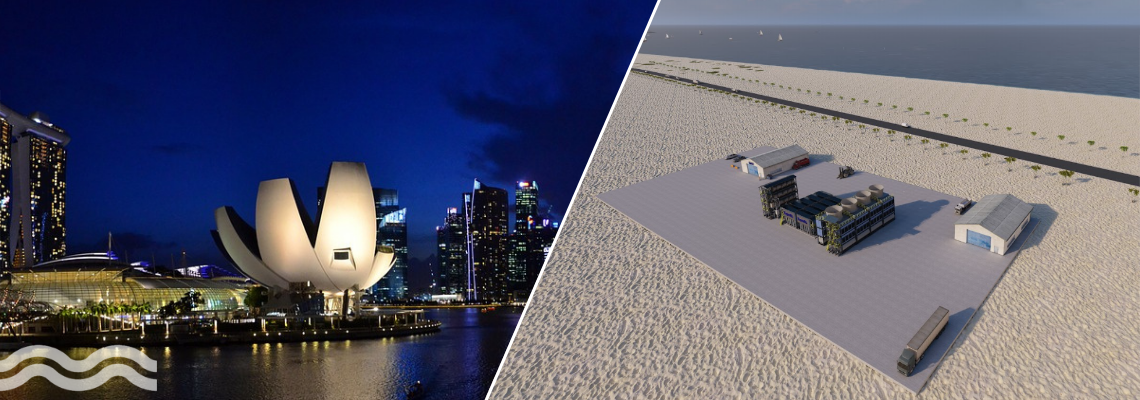Following two successful pilot projects, Singapore national water agency, PUB and Equatic will build the world’s largest ocean-based carbon dioxide removal plant in Tuas, Singapore to demonstrate and test the technology’s effectiveness and potential future scalability.
The world’s largest ocean-based carbon dioxide removal plant
Following two successful pilot projects, PUB and Equatic will build the world’s largest ocean-based carbon dioxide removal plant in Tuas, Singapore to demonstrate and test the technology’s effectiveness and potential future scalability.
The first module will be commissioned in mid-2024, with the demonstration phase expected to last 18 months.
Edward Sanders, COO of Equatic told Aquatech Online: “Equatic-1 will consist of individual modules containing one electrolyser each. The first phase of the project will bring a single module online. Nine additional modules will be installed to achieve the full scale of the demonstration plant — and prove the technology’s ability to scale to gigaton scale.”
The process removes carbon dioxide from seawater using a form of electrolysis, producing clean hydrogen and solids as by-products.
“Equatic technology consists of electrolysis and direct air capture to remove carbon from the atmosphere and produce carbon-negative hydrogen. During the electrolysis stage, Equatic-1 utilizes oxygen-selective anodes developed with the support of the Department of Energy’s Advanced Research Projects Agency-Energy (ARPA-E) to produce carbon-negative hydrogen, while eliminating the unwanted production of chlorine gas.
“Following the electrolysis step, the two streams of water (one acidic, one alkaline), are treated,” Sanders added.
The water is then returned to the ocean where it has the potential to capture more carbon dioxide. The process is repeatable, creating an efficient carbon capture cycle.
From pilot to demonstration plant
“At PUB, we firmly believe that technological advancements, delivered in partnership with academia and the private sector, hold the key to addressing the complex challenges posed by climate change,” said Dr Pang Chee Meng, PUB’s chief engineering and technology officer.
Equatic’s first pilot operations were unveiled at the Port of Los Angeles, USA, and Singapore in April 2023, less than two years after bench-scale prototypes were trialled at UCLA in 2021.
Equatic co-founder Gaurav N. Sant said: “Scaling carbon dioxide removal solutions requires technology, bold and committed partners, and a focus on timely and measurable success. We have been very fortunate to create this shared vision with our partners in Singapore to pilot and scale Equatic’s solutions.”
Why is carbon removal important?
In 2022, the UN released a report stating that carbon removal from the atmosphere was vital if the world wanted to achieve net zero emissions, with industry releasing 36 billion ton of the gas into the atmosphere the previous year.
Oceans are the largest carbon dioxide sinks on the planet, holding 150 times more than the air. However, the efficiency of seawater to absorb carbon dioxide decreases as levels of the gas increase, meaning more stays in the atmosphere, which can have detrimental effects on the climate.
PUB and Equatic’s pilot projects suggested that when seawater processed in the plant is returned to the oceans it would have an increased capacity to absorb atmospheric carbon dioxide.
“The pilot plant commissioned in Singapore in 2023 provided critical performance data to substantiate our carbon dioxide-removal efficiencies, hydrogen-production rates and energy requirements for the process,” added Equatic co-founder Dante Simonetti. “The findings helped define the pathway for the design and engineering of Equatic-1 based on scaling performance confirmed by the pilot system.”
The benefits of removing carbon dioxide do not stop there. Initially, Equatic-1 will be connected to the grid. However, Equatic is reviewing several renewable sources to power the plant.
Sanders added: “There is the potential to use the hydrogen produced to dramatically lower the net energy intensity of the carbon dioxide removal process, which is unlike most other CDR technologies.”
How much carbon is removed?
The plant will build on the existing pilot which successfully removed 0.1 metric tons of carbon dioxide from seawater every day. The demonstration plant will be equipped to remove 10 metric tons, 100 times more than the pilot.
It is estimated that 1,800 industry-scale units would remove 10 billion tons of atmospheric carbon dioxide annually.
The plant is based on the principles of modularity that will make it easier to scale the technology according to local need. Seawater flows through the system from PUB’s adjacent desalination plants.
An electric current is passed through the water as it flows past mesh electrodes that utilise Equatic’s oxygen-selective anodes. Chemical reactions break the water into carbon-negative hydrogen and oxygen constituents. The solids produced as a result can store carbon dioxide for thousands of years and can either be utilised in industries such as concrete and cement or released safely back into the ocean.
Carbon removal as part of PUB’s net zero ambitions
As Singapore’s national water utility, PUB has set itself a target of achieving net zero emissions by 2045. Its strategy includes reducing the energy requirements of its water treatment processes, and capturing and removing carbon released into the atmosphere.
The carbon removal plant has the potential to make a significant contribution to achieving PUB’s target, especially as it is designed to run on renewable energy.
Globally, the modularity and scalability of this approach will have a much broader appeal if the plant proves a success. It has many advantages over traditional carbon capture and storage approaches, whether land or water based. It removes the need for complex logistics, solvents, additives, pipelines, compression, and membranes that are prone to fouling. At the same time, Equatic expects the technology employed within the plant to bring removal costs below industry targets well before 2030.







